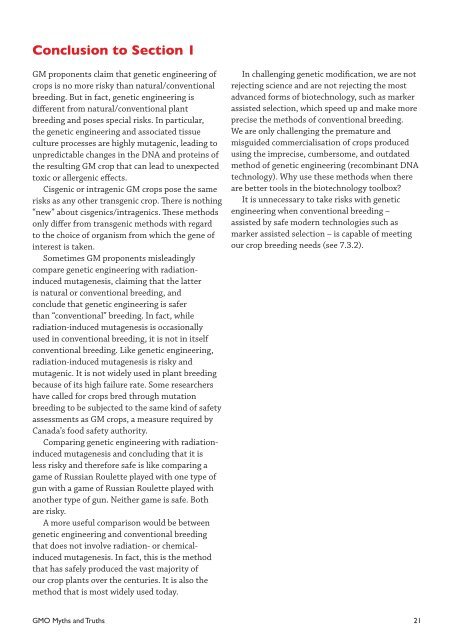GMO Myths and Truths
GMO Myths and Truths
GMO Myths and Truths
Create successful ePaper yourself
Turn your PDF publications into a flip-book with our unique Google optimized e-Paper software.
Conclusion to Section 1<br />
GM proponents claim that genetic engineering of<br />
crops is no more risky than natural/conventional<br />
breeding. But in fact, genetic engineering is<br />
different from natural/conventional plant<br />
breeding <strong>and</strong> poses special risks. In particular,<br />
the genetic engineering <strong>and</strong> associated tissue<br />
culture processes are highly mutagenic, leading to<br />
unpredictable changes in the DNA <strong>and</strong> proteins of<br />
the resulting GM crop that can lead to unexpected<br />
toxic or allergenic effects.<br />
Cisgenic or intragenic GM crops pose the same<br />
risks as any other transgenic crop. There is nothing<br />
“new” about cisgenics/intragenics. These methods<br />
only differ from transgenic methods with regard<br />
to the choice of organism from which the gene of<br />
interest is taken.<br />
Sometimes GM proponents misleadingly<br />
compare genetic engineering with radiationinduced<br />
mutagenesis, claiming that the latter<br />
is natural or conventional breeding, <strong>and</strong><br />
conclude that genetic engineering is safer<br />
than “conventional” breeding. In fact, while<br />
radiation-induced mutagenesis is occasionally<br />
used in conventional breeding, it is not in itself<br />
conventional breeding. Like genetic engineering,<br />
radiation-induced mutagenesis is risky <strong>and</strong><br />
mutagenic. It is not widely used in plant breeding<br />
because of its high failure rate. Some researchers<br />
have called for crops bred through mutation<br />
breeding to be subjected to the same kind of safety<br />
assessments as GM crops, a measure required by<br />
Canada’s food safety authority.<br />
Comparing genetic engineering with radiationinduced<br />
mutagenesis <strong>and</strong> concluding that it is<br />
less risky <strong>and</strong> therefore safe is like comparing a<br />
game of Russian Roulette played with one type of<br />
gun with a game of Russian Roulette played with<br />
another type of gun. Neither game is safe. Both<br />
are risky.<br />
A more useful comparison would be between<br />
genetic engineering <strong>and</strong> conventional breeding<br />
that does not involve radiation- or chemicalinduced<br />
mutagenesis. In fact, this is the method<br />
that has safely produced the vast majority of<br />
our crop plants over the centuries. It is also the<br />
method that is most widely used today.<br />
In challenging genetic modification, we are not<br />
rejecting science <strong>and</strong> are not rejecting the most<br />
advanced forms of biotechnology, such as marker<br />
assisted selection, which speed up <strong>and</strong> make more<br />
precise the methods of conventional breeding.<br />
We are only challenging the premature <strong>and</strong><br />
misguided commercialisation of crops produced<br />
using the imprecise, cumbersome, <strong>and</strong> outdated<br />
method of genetic engineering (recombinant DNA<br />
technology). Why use these methods when there<br />
are better tools in the biotechnology toolbox?<br />
It is unnecessary to take risks with genetic<br />
engineering when conventional breeding –<br />
assisted by safe modern technologies such as<br />
marker assisted selection – is capable of meeting<br />
our crop breeding needs (see 7.3.2).<br />
<strong>GMO</strong> <strong>Myths</strong> <strong>and</strong> <strong>Truths</strong> 21


